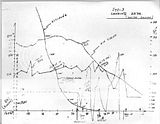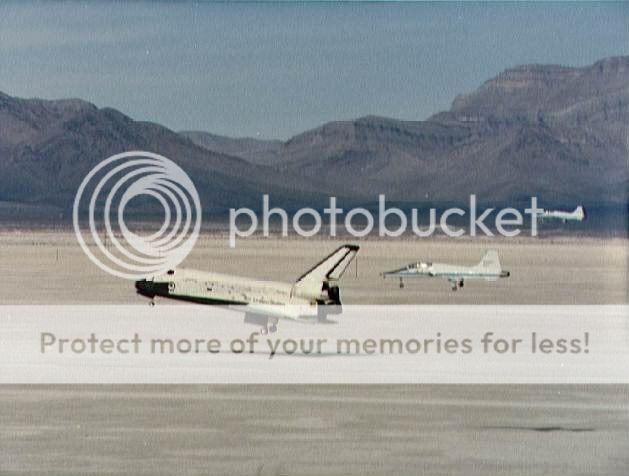J
job1207
Guest
http://spaceflightnow.com/shuttle/featu ... 03_qt.html
a video of the STS 3 landing. Note the whoa, as the nose goes up.
a video of the STS 3 landing. Note the whoa, as the nose goes up.
If it is on the net, copy image location/URL to the post, and enclose it with image tags, like this :shuttle_guy":278xikc8 said:I have a plot of the STS-3 landing data showing air speed. angle of attack. hand controller inputs ets which is very interesting. It was drawn at White Sands while I was there for the landing. How do I attach a picture to a post?
[img]http://t1.gstatic.com/images?q=tbn:1Ewh4-y4EH8IaM:http://www.wired.com/images_blogs/photos/uncategorized/2008/08/07/x37b.jpg[/img]
[url=http://www.wired.com/images_blogs/photos/uncategorized/2008/08/07/x37b.jpg][img]http://t1.gstatic.com/images?q=tbn:1Ewh4-y4EH8IaM:http://www.wired.com/images_blogs/photos/uncategorized/2008/08/07/x37b.jpg[/img][/url]
trailrider":16cjhhm2 said:SG:
Could you answer a question for me? In the most recent issue of Air & Space Smithsonian, there is an article about the Shuttle and various changes that were made to it over the course of the program. (Note: prior to 1986 I worked on SRB Decelerator Subsystem for Martin-Marietta, hence my curiosity about the following.)
According to the article, about 1994 "the main chute diameters were increased from 115 ft. in diameter to 136 ft."
Now, back when I was on the program, the main chutes were 136 ft. spherical canopy ribbon chutes. At the time when there were plans to replace the maraging steel boosters with filament wound, lightweight boosters, the plan was to reduce the diameter to 115 ft. Kevlar ribbon chutes. When the filament wound cases were eliminated, so were the 115 ft. chutes. My question: Did they go to the smaller chutes and then switch back? Or did the writer in A&S Smithsonian make a mistake? :?:

 FULL RESOLUTION GRAPHIC HERE
FULL RESOLUTION GRAPHIC HERE
nimbus":388l699d said:Or you can send it to one of us who'll be glad to upload it to a hosting service for you, SG.
nimbus":99ttawz0 said:Altitude, airspeed, angle of attack, and RHC. RHC is pitch input from Jack Lousma?
stevekk":2r7k35p8 said:Its unfortunate that NASA isn't leading this basic research mission. I see that as one of their core missions, but I guess it's a lot easier to find a few spare billions in the defense department than it is within NASA.
I read somewhere that the Shuttle was designed for 100 flights, but that was with a much quicker turnaround between flights. They never thought it would take 30 years just to get 30 flights off the ground.
perhaps this X-37 can fulfill the shuttle's promise of a 2-week turnaround between missions. I assume we have learned a few lessons in the last 30-40 years about TPS technology also.
X-37B FLARES: Multiple observers are reporting "X-37B flares." When the USAF space plane flies overhead, it suddenly increases in brightness five-fold or more. Amateur astronomer Bryan Murahashi photographed the phenomenon on March 30th when the X-37B cut through the Big Dipper over San Jose, California:
Photo details: Nikon D300, 26s, f/2.8 at 24.0mm, ISO320
"The space plane brightened at least two magnitudes," says Murahashi. "It was a very neat thing to see."
job1207":3svdzonz said:stevekk":3svdzonz said:I read somewhere that the Shuttle was designed for 100 flights, but that was with a much quicker turnaround between flights. They never thought it would take 30 years just to get 30 flights off the ground.
.
EarthlingX":feu474rv said:http://spaceweather.com/archive.php?view=1&day=01&month=06&year=2010
X-37B FLARES: Multiple observers are reporting "X-37B flares." When the USAF space plane flies overhead, it suddenly increases in brightness five-fold or more. Amateur astronomer Bryan Murahashi photographed the phenomenon on March 30th when the X-37B cut through the Big Dipper over San Jose, California:
Photo details: Nikon D300, 26s, f/2.8 at 24.0mm, ISO320
"The space plane brightened at least two magnitudes," says Murahashi. "It was a very neat thing to see."

shuttle_guy":kpd89vmc said:job1207":kpd89vmc said:stevekk":kpd89vmc said:I read somewhere that the Shuttle was designed for 100 flights, but that was with a much quicker turnaround between flights. They never thought it would take 30 years just to get 30 flights off the ground.
.
Yes the Orbiter is designed for 100 flight. BTW we have launched 132 flight in slightly less that 30 years.
shuttle_guy":2acn5u71 said:EarthlingX":2acn5u71 said:http://spaceweather.com/archive.php?view=1&day=01&month=06&year=2010
X-37B FLARES: Multiple observers are reporting "X-37B flares." When the USAF space plane flies overhead, it suddenly increases in brightness five-fold or more. Amateur astronomer Bryan Murahashi photographed the phenomenon on March 30th when the X-37B cut through the Big Dipper over San Jose, California:
Photo details: Nikon D300, 26s, f/2.8 at 24.0mm, ISO320
"The space plane brightened at least two magnitudes," says Murahashi. "It was a very neat thing to see."
This is probably due to attitude changes (hopefully commanded attitude changes).
Shuttle Guy - Why go with a twisty joystick instead of conventional 2 axis joystick + rudder pedals? What controls are the CDR/pilot's feet and other hand using meanwhile?nimbus":3pjd1ilh said:twisty joystick.
nimbus":2oxgmopi said:Shuttle Guy - Why go with a twisty joystick instead of conventional 2 axis joystick + rudder pedals? What controls are the CDR/pilot's feet and other hand using meanwhile?nimbus":2oxgmopi said:twisty joystick.


